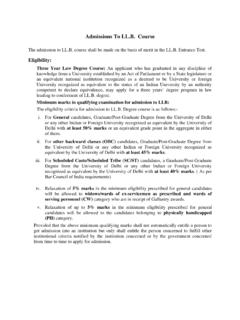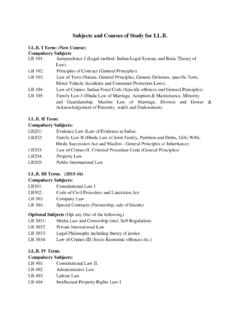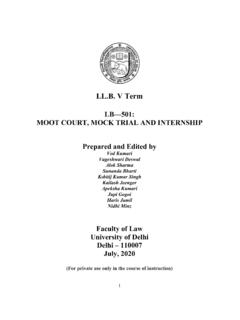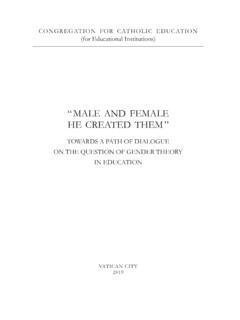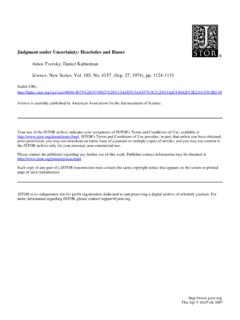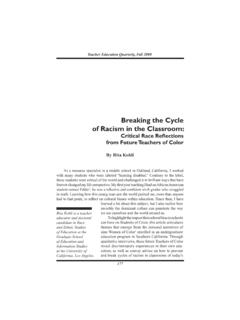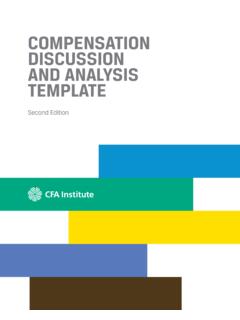Transcription of LL.B. V Term LB 502 Drafting, Pleadings and Conveyance
1 V Term LB 502 Drafting, Pleadings and Conveyance Prepared by Diksha Munjal Shankar Isha Wadhwa Sharma Kailash Jeenger Pooja Devi FACULTY OF LAW, UNIVERSITY OF DELHI July, 2020 (For private use only in the course of instruction) ii V Term Paper: LB 502 - Drafting, Pleadings and Conveyance Note: This is a kind of practical paper, related to purely procedural aspect of the legal profession, wherein it is difficult to explain the concepts theoretically. Depending upon the facts of particular matter students, in the capacity of a lawyer, would be required to do Drafting of: various applications, petitions and replies etc.
2 Of a particular litigation which constitute part of the court proceedings falling under Pleadings ; and documents, reflecting Conveyance of property from one person to another person. Depending upon the nature of such dealings/transactions between the parties qua that property nomenclature of such a document is done. This part falls under Conveyancing . In this scenario, the students would be required to undertake, under this subject, to do these practical exercises in the class itself under the guidance of their teacher, after recollecting what they have learnt in the other substantive subjects during their Course.
3 For that reason, no specific book is being recommended for the present paper. Therefore, keeping in view the nature of this paper, there is no substitute of class lectures of the present subject. PURPOSE OF LAW IS TO HAVE PEACE IN THE SOCIETY It is needless to emphasize the importance of peace in society, since we cannot enjoy life to its fullest extent without peace. This aspect is further substantiated in terrorist-stricken world of today, where in the agenda of every world leader peace finds top priority.
4 In fact, peace means and exists when there is no dispute. The dispute arises only when a person claims his right over a particular thing and the same is disputed by the other, which creates tension and ultimately leads to breach of peace. Here law plays a very vital and significant role in the society, because through justice delivery system it adjudicates these kinds of disputes, arising out of clash of interests amongst the people. LAW CAN BE SUBSTANTIVE LAW OR PROCEDURAL LAW The law can be substantive law or procedural law.
5 The substantive law is the one which actually decides the rights, liabilities and duties of the respective persons. On the other hand, the procedural law is the one which lays down guidelines as to how to decide those rights, liabilities and duties. In other worlds, the procedural law lubricates substantive law. It helps in iii determining the rights, liabilities and duties of the litigants. It is procedural law which puts life into the substantive law by providing remedy for enforcement of those rights and liabilities.
6 In this way, both the branches of law are complementary to each other and at the same time independent of each other. Indian Penal Code, 1860, Customs Act, 1962, Prevention of Food Adulteration Act,1954, Sale of Goods Act, 1930,Transfer of Property Act, 1982 and Rent Control Legislations, etc. are the examples of substantive laws, whereas Code of Criminal Procedure, 1973, Code of Civil Procedure, 1908, Indian Evidence Act, 1872, etc. are procedural laws. However, there are certain laws, regarding which, due to the nature of their provisions and the object, for which they were legislated, it is difficult to point out as to whether they are substantive laws or procedural laws.
7 In such cases, on one hand the provision of such a law provides procedure for enforcement of certain rights and at the same time violation of that procedure leads to taking away of that substantive right of the violator. For example, under the Registration Act, 1908 if a particular document, which requires compulsory registration, is not registered then the party to that document, claiming right on the strength of the contents of the said document would not be able to establish his substantive right under that unregistered instrument.
8 Pleadings It would be beneficial to distinguish between the Pleadings and conveyancing. The dictionary meaning of the term plead means to state and argue a case . Therefore, pleading comprises of respective contentions of the parties in a dispute, which are reduced into writing. Pleadings , under Civil as well as Criminal Law, meant that to determine what the parties were currently fighting about. Pleading is the beginning stage of a lawsuit in which parties formally submit their claims and defences.
9 In Civil proceedings the plaintiff submits a plaint stating the cause of action -- the issue or issues in controversy. The defendant submits an answer- the reply- the written statement- stating his or her defences and denials. In other words it is nothing but the formal presentation of claims and defences by parties to a lawsuit. Therefore, it includes every legal document filed in a lawsuit, petition, motion and/or hearing, including complaint, petition, answer/reply, rejoinder, motion, declaration and memorandum of points and authorities (written argument citing precedents and statutes).
10 Hence, the term pleading would be applicable to the Court proceedings including filing of the complaint/plaint, etc., replies thereto and other incidental documents related to the dispute filed by either of the parties. Needless to mention here that, our legal system is adversary legal system wherein there are two contesting parties. One party stakes its claim or right to a particular thing, which is disputed by the opposite side before the Court.
